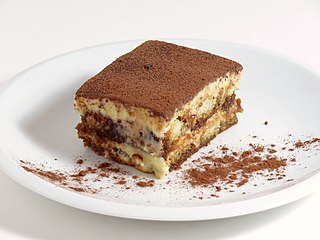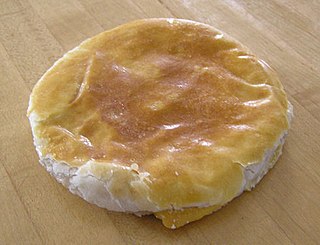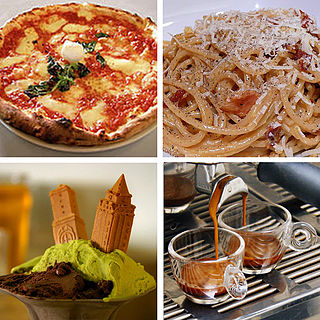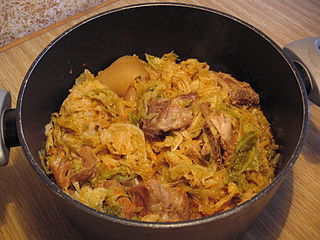| Alternative names | Spongarda di Crema |
|---|---|
| Type | Cake |
| Place of origin | Italy |
| Region or state | Crema, Lombardy |
| Serving temperature | Room temperature |
| Main ingredients | Flour, butter, sugar, honey, almonds, spices, hazelnuts, walnuts, candied fruit, raisin, pine nuts |
| Ingredients generally used | Mostaccino , cinnamon, turmeric, vanilla essence, apricot jam |
| Variations | Torrone |
Spongarda is a local cake originating in the comune (municipality) of Crema.[ citation needed ] The Lombardy region includes it as spongarda of Crema in the list of traditional food products. [1]
In Crema the name has been documented since 1755, [2] but its origins date back to a kind of pastry quoted by a historian from Crema, Pietro Terni, for a feast in 1526, a soft and spongy [3] cake, from the Latin spongia. [4]
Spongarda is a flat cake, made of a compact dough, gently pinched and pierced on the sides and on the top. It has a rich filling stuffed with dried fruit, candied fruit and spices. The recipe refers to other cake in other regions, the spongata of Brescello and the spungata of Sanzana are among the most famous. The origins of the filling date back to the Renaissance as regards the use of spices. [5] It is produced in bakery laboratories of Crema, being a complex pastry. In 2009 some of them got associated to the so-called Congrega della Spongarda (lit. 'Coven of Spongarda') in order to protect and promote its spread outside its original area. [6]
It is prepared with flour, sugar, butter, honey, cinnamon, spices, almonds, walnuts or hazelnuts, raisin and candied fruit. [7] Some people crumble within a mostaccino (spicy biscuit of Crema used in tortelli cremaschi ) instead of using spices.

Tiramisu is an Italian dessert made of ladyfinger pastries (savoiardi) dipped in coffee, layered with a whipped mixture of eggs, sugar and mascarpone and flavoured with cocoa. The recipe has been adapted into many varieties of cakes and other desserts. Its origin is disputed between the Italian regions of Veneto and Friuli-Venezia Giulia. The name comes from the Italian tirami su.

Mascarpone is a soft Italian acid-set cream cheese. It is recognized in Italy as a prodotto agroalimentare tradizionale.

A sweetheart cake or wife cake or marriage pie is a traditional Chinese cake with a thin crust of flaky pastry, made with a filling of winter melon, almond paste, and sesame, and spiced with five spice powder. "Wife cake" is the translation of 老婆饼 from Chinese, and although the meaning is "wife", the literal translation is "old lady cake", paralleling the colloquial usage of "old lady" for "wife" in English. In Hong Kong, it is known as a specialty of the Yuen Long District.

Capocollo or coppa is a traditional Italian and French (Corsica) pork cold cut (salume) made from the dry-cured muscle running from the neck to the fourth or fifth rib of the pork shoulder or neck. It is a whole-muscle salume, dry cured, and typically sliced very thin. It is similar to the more widely known cured ham or prosciutto, because they are both pork-derived cold cuts used in similar dishes. It is not brined as ham typically is.

Crema is a city and comune in the province of Cremona, in the region of Lombardy in northern Italy. It is built along the river Serio at 43 km (27 mi) from Cremona. It is also the seat of the Catholic Bishop of Crema, who gave the title of city to Crema.
Slinzega is a type of air-dried meat produced in Valtellina and Valchiavenna valleys, in the Italian Alps. It is made in a similar manner to bresaola, with smaller pieces of meat, which therefore bear a stronger taste. According to some sources, it originally used horse meat rather than beef. Nevertheless, today virtually any type of meat is suitable for its production; the most common being beef, deer and pork.

Italian cuisine is a Mediterranean cuisine consisting of the ingredients, recipes and cooking techniques developed in Italy since Roman times and later spread around the world together with waves of Italian diaspora. Some of these foods were imported from other cultures. Significant changes occurred with the colonization of the Americas and the introduction of potatoes, tomatoes, capsicums, maize and sugar beet—the latter introduced in quantity in the 18th century. It is one of the best-known and most appreciated gastronomies worldwide.

Casunziei is the name in Ladin for a type of stuffed pasta, consisting of a filling sealed between two layers of thin pasta dough, folded in a typical half-moon shape. They are commonly homemade and are typical of the culinary tradition of the Dolomites area, in the northeastern part of Italy, especially the provinces of Belluno, Bolzano, and Trento.

Mustacciuoli, also known as mustaccioli or mostaccioli, is a traditional pastry from Naples, Italy, usually served at Christmas time.

Lombard cuisine is the style of cooking in the Northern Italian region of Lombardy. The historical events of its provinces and of the diversity of its territories resulted in a varied culinary tradition. First courses in Lombard cuisine range from risottos to soups and stuffed pasta, and a large choice of second course meat or fish dishes, due to the many lakes and rivers of Lombardy.

Formai de Mut dell'Alta Valle Brembana is an Italian cheese prepared from raw cow's milk that originated in Lombardy, Italy. It is prepared in a similar manner to Fontina d'Aosta cheese at Alta Valle Brembana in high pasture lands and in Bergamo, Lombardy. It is rarely found outside of Lombardy, and it is produced in "very limited quantities". It was classified with a protected designation of origin status in 1996.
Treccia d'oro is a baked cake made of yeast dough and candied fruit, originally from the Italian comune (municipality) of Crema.

Pomodorino di Manduria is an ecotype of tomato typical of Manduria, a city in the province of Taranto. In the local dialect, it is also called "pummitoru paisanu".

Pane di Laterza is a traditional bread of Laterza, a comune (municipality) in the province of Taranto, Apulia. It is made with durum flour with water, salt and sourdough. It is mainly produced in Laterza, but it can be also found in neighbouring municipalities. It has been recognised by the Italian Ministry of the Agriculture, Food and Forestry Policies as prodotto agroalimentare tradizionale (PAT) of Apulia.

The sfincia di San Giuseppe is a typical Sicilian pastry dessert, traditionally prepared for the day of Saint Joseph. It is recognised as prodotto agroalimentare tradizionale (PAT) by the Italian Ministry of Agricultural, Food and Forestry Policies.

Ligurian cuisine consists of dishes from the culinary tradition of Liguria, a region of northwestern Italy, which makes use of ingredients linked both to local production, and to imports from areas with which, over the centuries, the Ligurians have had frequent trade.

The cuisine of Basilicata, or Lucanian cuisine, is the cuisine of the Basilicata region of Italy. It is mainly based on the use of pork and sheep meat, legumes, cereals and vegetables, with the addition of aromas such as hot peppers, powdered raw peppers and horseradish. The local gastronomy is, for historical-cultural reasons, typically peasant, based on simple recipes and on the culture of reuse, in particular of meat and bread.
{{cite web}}: Check |url= value (help)